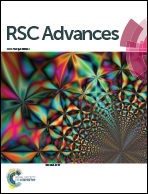Salt mediated unusual switching in the aggregation kinetic profile of human carbonic anhydrase†
Abstract
The protein aggregation behaviour is highly dependent on the physico-chemical environment of the protein. Even marginal changes of the solution conditions can severely affect or perturb the aggregation pathway, kinetics and the morphology of the aggregated state. Here, we report an interesting change in the aggregation profile of human carbonic anhydrase II on the addition of salt. Our principal observation is that the salt ions alter the monophasic aggregation kinetics of HCA II to biphasic at 328 K. Solubility studies show that the major portion of soluble protein gets incorporated into aggregates during the first transition. During the second transition, there is just a fusion of pre-formed aggregates resulting in large-sized aggregate clusters. Both the transitions are second order processes, however, the forces responsible for the growth during the two transitions are different as the rate and extent of aggregation are affected differently with increasing salt concentration for two transitions. At the same salt concentration, the cations follow the Hofmeister series in modulating the HCA II aggregation, suggesting a possible role of protein–ion and water–ion interactions along with the changes in general water structure. Temperature dependence studies of the biphasic profile suggest a low and high activation barrier for first and second transition, respectively.


 Please wait while we load your content...
Please wait while we load your content...